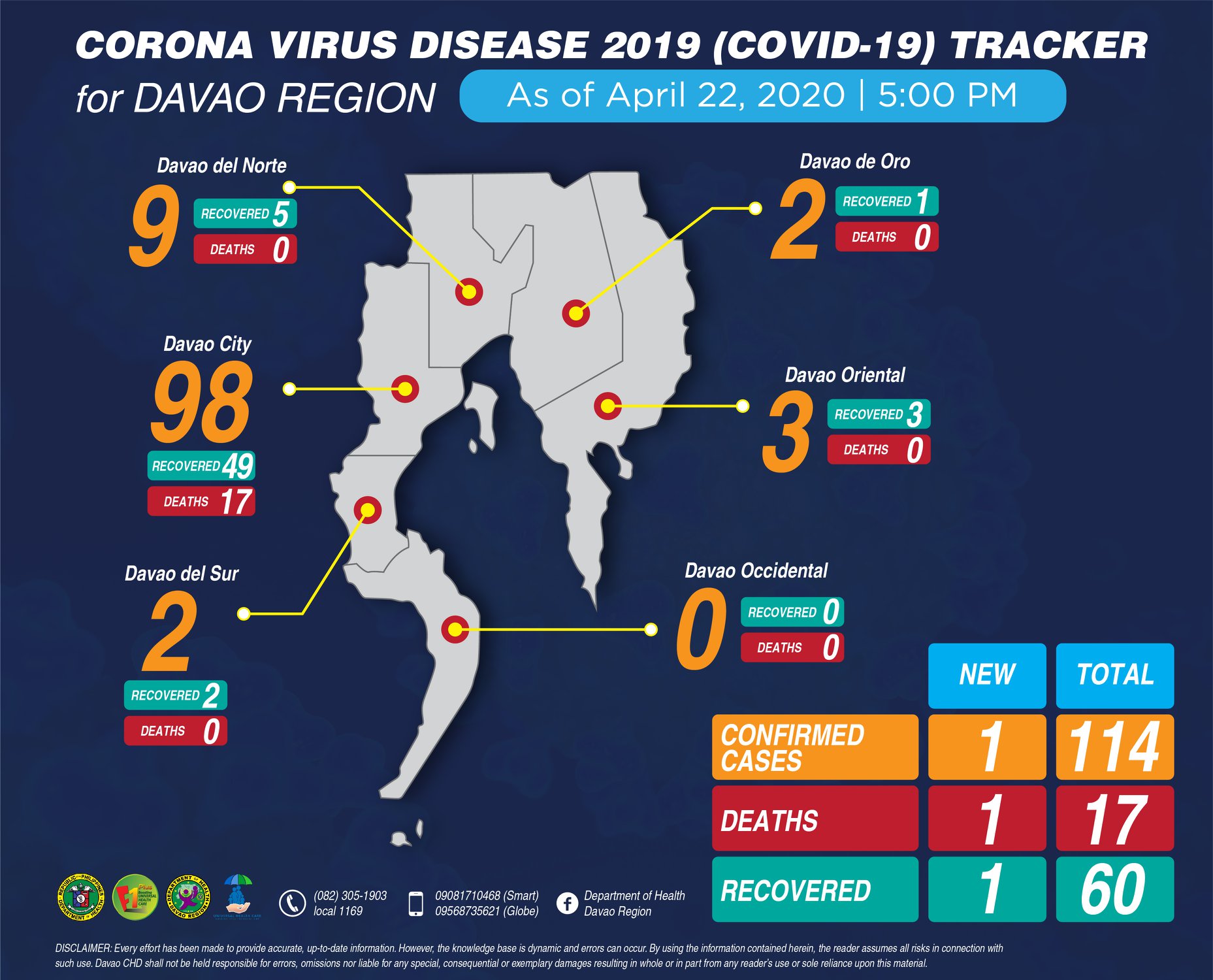
An official of the Department of Health in Davao Region revealed that Region XI has a current total of 108 cases of Coronavirus Disease-19 with three new cases reported 5:00 pm on April 20.
Dr. Lenny Joy Rivera, assistant regional director of the Department of Health XI said that of this number, 30 health workers were found to be COVID-19 positive and six had a history of travel.
In a virtual presser by the Philippine Information Agency in Davao Region she said clustering of cases was also done in two events setting, one is related to work-health facilities and another one was in Matina Gallera.
Rivera said the most common symptoms shown by the COVID-19 positive patients in Davao Region range from cough, fever, chills, and colds.
“No new death was reported yesterday, sustaining a total number of 15 percent of the total number of cases in the region,” she said.
Rivera also noted no case of recovery or discharge was reported yesterday, maintaining a total number of 53 percent of all the cases.
She said that out of the 108 confirmed cases of Covid-19 in the region, 103 had been subjected to initial contact tracing where 2,513 or 93.4 percent of closed contacts had been recorded and monitored.
Rivera said that the contact tracing is being conducted by the Criminal Investigation and Detection Group, the Department of Interior and Local Government and the National Intelligence Coordinating Agency.
She also said that a total of 1,388 suspected cases had been reported and 142 are currently admitted and swabbed in various COVID-19 facilities in the region.
Rivera said that a cumulative number of 25,667 persons under monitoring cases were reported.
Of these PUM cases, 20,693 or 81 percent had been cleared.
“Currently, tinitingnan pa rin natin ang ating mga PUMs kahit may bago tayong classification. Sila yung dati nating mga PUMs na minomonitor ng BHERTS, We are still monitoring them, especially their closed contacts without signs and symptoms. Sila yung mga minomonitor and considered as PUM,” she said.
Rivera said that the main age affected would range from 40 to 49 years old or 22 percent of the total cases at 108.
She said that the youngest age is four-years-old and the oldest case is 82 years old based on yesterday’s data.
Rivera said that when it comes to mortality, there was no death below 30 years old. She said there was increased mortality between the ages of 50 and 59 years old.
Rivera said most of those who died in Davao Region were at this age range.
She said that by gender, there were 70 percent male and 30 percent female. “That was our data on the COVID-19 status in Davao Region,” Rivera said.
Dr. Mary Elinore Conca, chief training officer of the SPMC said the facility has 93 confirmed COVID-19 positive cases, three new positive cases, as of yesterday.
She said that from April 16 to April 20, there were six new cases on April 19.
“It means that the COVID-19 is still in our midst, and transmission is still happening. We could not also say that the Enhanced Community Quarantine has no effect since through the ECQ, our cases did not increase unlike at the time when everything started, as shown on the first part of the graph, the highest was 20. So, we hope to comply with the ECQ, as it limits the transmission of the infection,” Concha said.
She said their number of recoveries is steady at 46 and the number of deaths stayed at 17.
Concha said that in the past five days, the number seems to stabilized.
She said that what is alarming is that during April 19 and 20, there were new positive cases which had not surpassed the percentage in the increase of cases just like the previous days.
Concha said there may still be transmission but since everyone is cooperating on the lockdown, it has limited the incidents of transmission.
On the other hand, Rivera said that of the six new COVID-19 cases, four of them had exposure to COVID based on contact tracing and history taking of the patients and one was exposed to a suspected person under investigation who was undergoing dialysis.
She said the sixth patient had an unknown exposure.
“If we look closely, the transmission occurred within the household and not from one household to another. So, we can tell that there are many cases, for example in Buhangin, there are ten cases seen there just like in Talomo Central. If we also look in other areas, with cases from five to nine, we have Calinan, Tugbok, Toril, Bunawan and Sasa. We also have to consider who among them is the index case. We could see that there are index cases taken from other places like history of travel,” Rivera said.
She said there are many cases in Buhangin, but the transmission was not acquired in the area alone.
Rivera said the index case does not only happen in Buhangin.
She said people were highly mobile and most of the positive patients had travel history and even went to the province or had been to other regions in the country.
Rivera said there were positive victims who acquired the transmission within the household.
“Our contact tracing could not establish transmission from one household to another,” she said. (PIA XI-Joey Sem G. Dalumpines)






